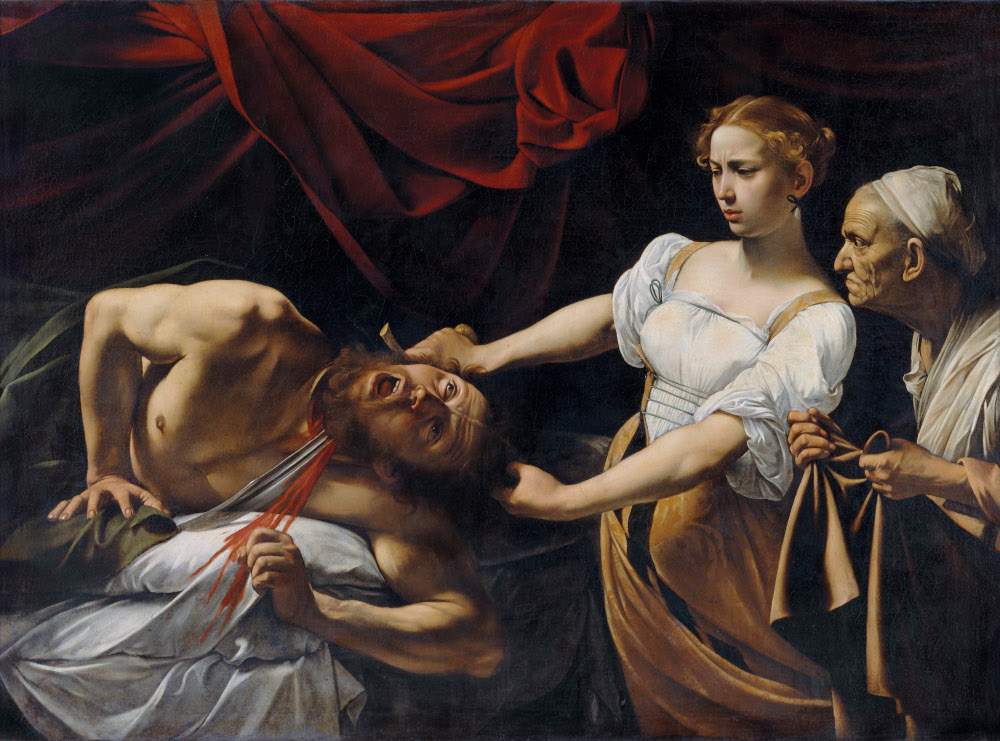The National Galleries of Ancient Art at Palazzo Barberini in Rome welcome from November 26, 2021 to March 27, 2022 the exhibition Caravaggio and Artemisia: The Challenge of Judith. Violence and Seduction in Painting between the Sixteenth and Seventeenth Centuries, curated by Maria Cristina Terzaghi.
The exhibition aims to shine a spotlight on Caravaggio’s famous canvas seventy years after its rediscovery and fifty years after its acquisition by the Italian state.
Two very important anniversaries to celebrate, as the director of the National Galleries Flaminia Gennari Santori. “This exhibition corresponds perfectly to my vision of a museum in continuous polyphonic narrative, comparison and exchange between collection and temporary exhibitions. A constantly evolving narrative with the aim of offering always different keys to interpretation to our visitors.”
Judith, among Caravaggio’s most famous works, was rediscovered in 1951 by Pico Cellini, one of the greatest restorers of the 20th century. After visiting the first major exhibition dedicated to Caravaggio and the Caravaggesque painters, held at the Palazzo Reale in Milan by Roberto Longhi, the restorer recalled that as a boy he had seen in a Roman palace a canvas depicting Judith and Holofernes attributed to Orazio Gentileschi, and traced it back to Caravaggio’s style. Pico Cellini managed to find the painting with its owner Vincenzo Coppi, photograph it, and show it to Longhi, who immediately asked for and obtained an extension to the exhibition to include it.
Completed in 1599 by Caravaggio for the Ligurian banker Ottavio Costa, who died in 1639, it was never alienated, remaining in Rome until the mid-19th century, when it passed into the ownership of Coppi’s ancestors, and then became part of the holdings of the National Galleries of Ancient Art in 1971. Jealous of the work, Costa prohibited not only its alienation but also its reproduction, which is why no faithful seventeenth-century copies exist. Despite the owner’s cautions, the composition still managed to circulate.
The exhibition at Palazzo Barberini displays thirty-one works, almost all of large format, from major national and international museums, including the Corsini Gallery and the Galleria Palatina in Florence; the Prado Museum and the Thyssen Bornemisza Museum in Madrid; the Gallerie d’Italia at Palazzo Zevallos Stigliano and the Capodimonte Museum in Naples; the Galleria Borghese in Rome; the Kunsthistorisches Museum in Vienna; and the Oslo Museum.
The exhibition is divided into four sections and opens with Judith at the Crossroads between Manner and Nature, a selection of sixteenth-century works that present the first evidence of a new representation of the theme, characterized by the violence of the biblical heroine’s gesture, as in paintings by Pierfrancesco Foschi, Lavinia Fontana, Tintoretto and a follower of Bartholomeus Spranger.
Caravaggio’s Judith Beheading Holofernes, the centerpiece of the second section devoted to Merisi and his early interpreters, puts an actual beheading on canvas, constituting a moment of rupture with tradition and finding a counterpart only in the coeval production of sacred representations and theatrical dramas. The vehemence of the crime, as opposed to the sensual beauty of Judith, will be a source of inspiration and reinterpretation of the biblical episode. On display in this section are the works of the earliest artists who had some knowledge of the canvas: Trophime Bigot, Valentin de Boulogne, Louis Finson, Bartolomeo Mendozzi, Giuseppe Vermiglio, and Filippo Vitale were inspired by Caravaggio’s painting in the horizontal format, with the three-quarter figures in their natural state, in the violence of the gestures, and in the depiction of Holofernes’ torment.
The greatest interpreter of the subject was Artemisia Gentileschi, to whom the third section Artemisia Gentileschi and the Theater of Judith is dedicated. Artemisia, together with her father Orazio, tried her hand at the subject several times. In addition to masterpieces by the two Gentileschi artists, the exhibition includes works by Giovanni Baglione, Johan Liss, Bartolomeo Manfredi, Pietro Novelli, Mattia Preti, Giuseppe Vermiglio and the rare Biagio Manzoni, one of the new additions to the exhibition.
The fourth and final section, The Virtues of Judith. Judith and David, Judith and Salome, is dedicated to the comparison of the theme of Judith and Holofernes and that of David and Goliath, which are united by the allegorical reading of the victory of virtue, cunning and youth over the brute force of the tyrant who is beheaded. On display are works by Valentin de Boulogne, the workshop of Giovanni Bilivert and Francesco Rustici.
The exhibition is accompanied by a catalog published by Officina Libraria, with a text by the curator, which delves into the history of Caravaggio’s Judith and that of Artemisia Gentileschi, recording the fallout of the two masterpieces in contemporary painting. The volume also collects essays by Elizabeth Cohen, Paola Cosentino, Filippo Maria Ferro, Lara Scanu, and Francesco Spina, devoted to the theme of social history and the role of women in early 17th-century Rome, to the literary and theatrical representation of the Judith episode in the Renaissance and Baroque periods, to the psychoanalytic reading of female trauma in the painting of the modern and contemporary ages, to the iconographic theme of Judith in European production between the sixteenth and seventeenth centuries, and finally giving an account of some documentary novelties decisive for the popularization of Caravaggio’s work in Rome and Naples.
For more info: www.barberinicorsini.org
Hours: Tuesday through Sunday from 10 a.m. to 6 p.m.
Image: Caravaggio, Judith Beheading Holofernes (c. 1599; oil on canvas, 145 x 195 cm; Rome, Gallerie Nazionali d’Arte Antica di Palazzo Barberini)
 |
| At Palazzo Barberini, Judith in painting between the sixteenth and seventeenth centuries, from Caravaggio to Artemisia |
Warning: the translation into English of the original Italian article was created using automatic tools. We undertake to review all articles, but we do not guarantee the total absence of inaccuracies in the translation due to the program. You can find the original by clicking on the ITA button. If you find any mistake,please contact us.